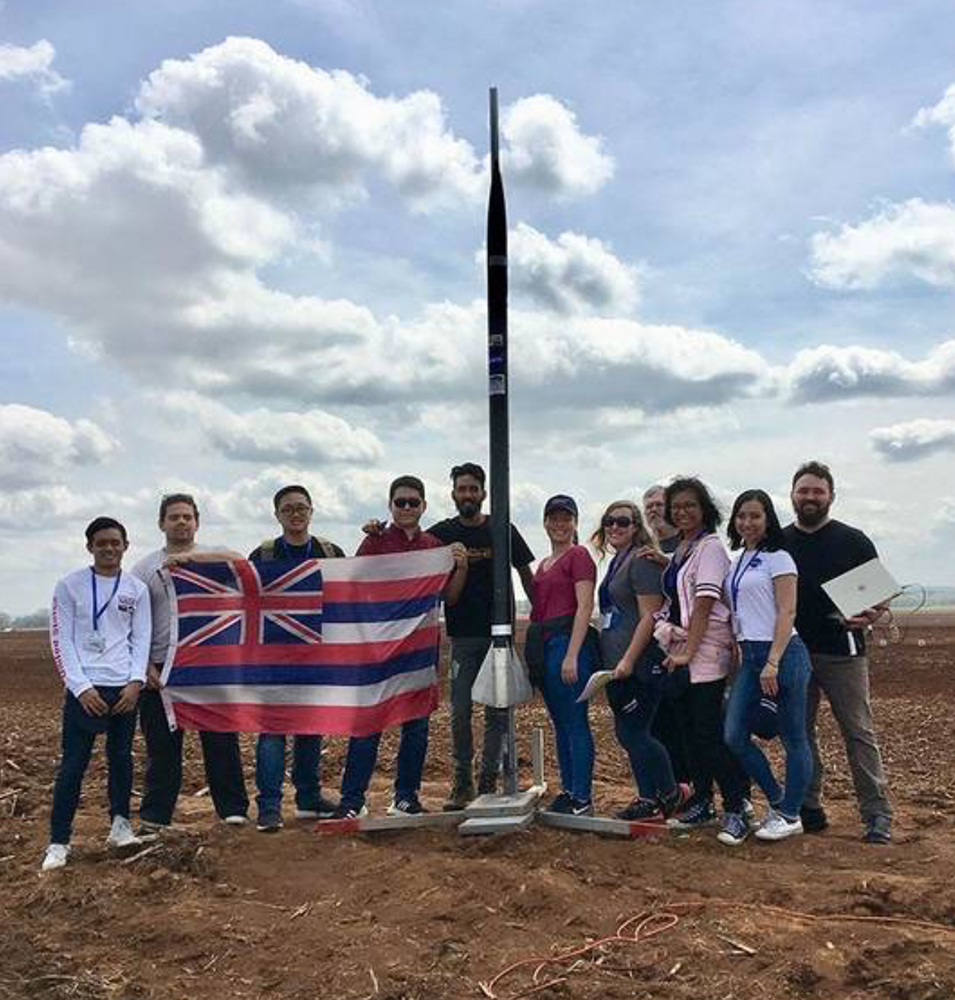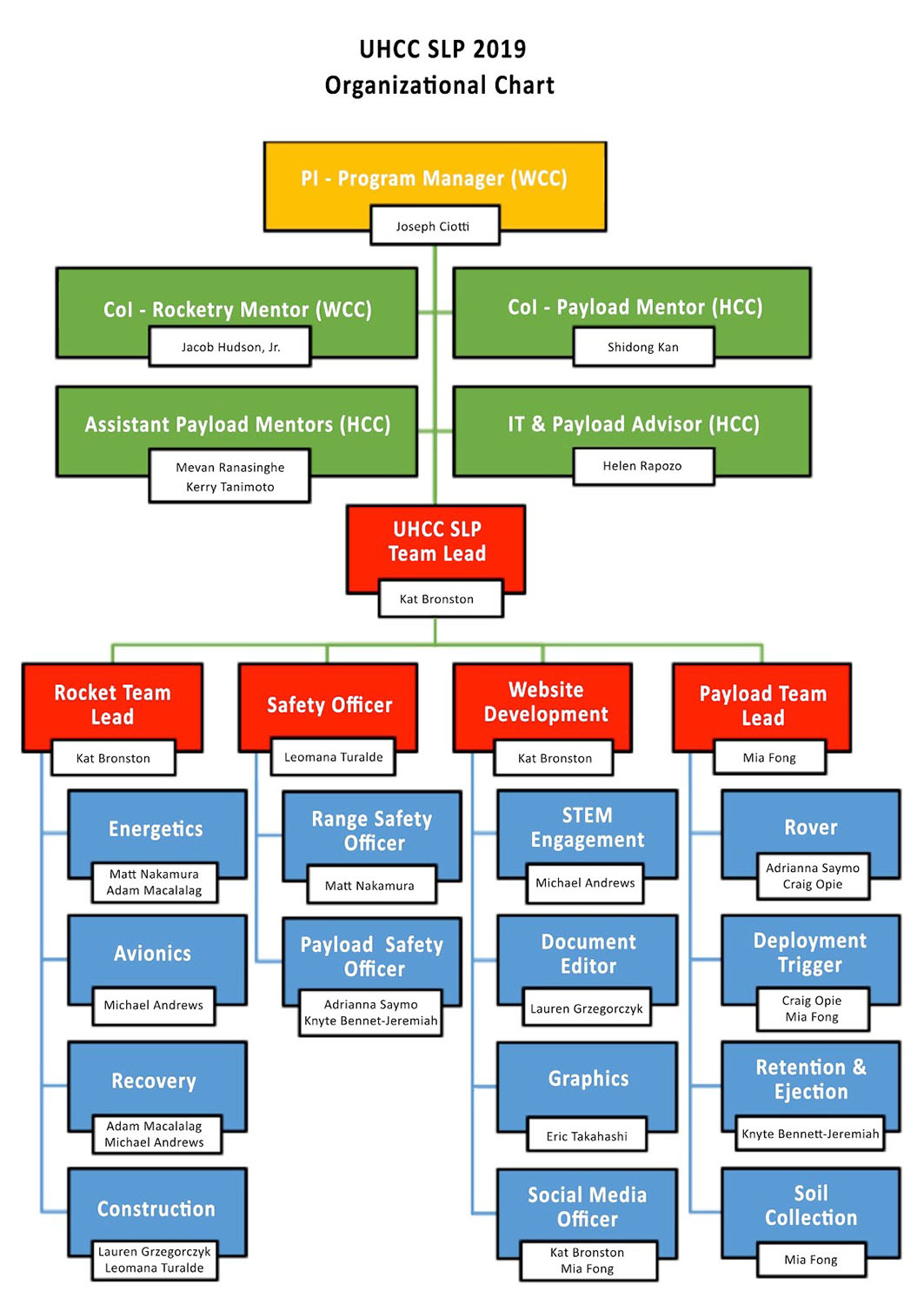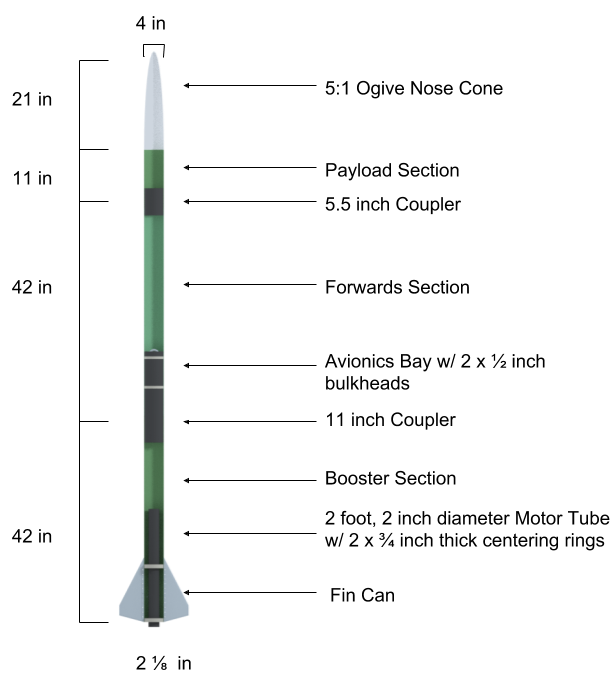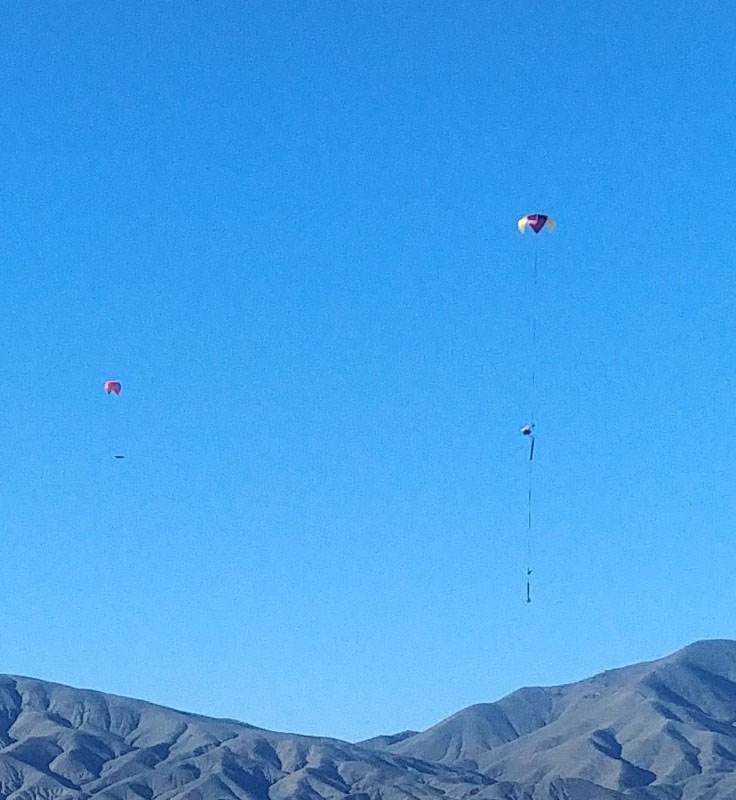NASA Student Launch Project
Honolulu—Kapi‘olani—Windward Community College & University of Hawai‘i at Mānoa
Hawai‘i Space Grant Consortium

About the NASA Student Launch Project
“Student Launch is a research-based, competitive, experiential exploration activity. It strives to provide relevant, cost-effective research and development of rocket propulsion systems. This project offers multiple challenges reaching a broad audience of middle and high schools, colleges, and universities across the nation.” (NASA)
For the Student Launch Project, teams construct both a launch vehicle and a payload specifically designed for the criteria of that year’s competition. For the 2019 SLP, launch vehicles must reach apogee between 4,000’ and 5,500’. The design of the launch vehicle must adhere to numerous regulations outlined in the NASA Student Launch Handbook.
For the 2019 SLP, teams were allowed to select from two different payload criterias. They either needed to design a UAV or a Rover (for soil collection). The Mission 6 Project Imua Team selected the Rover competition. Similar to the the vehicle, the payload is required to adhere to regulations also outlined NASA Student Launch Handbook.
Project Imua Mission 6 Team
The team that designed the SLP launch vehicle and rover comprised Mission 6 of Project Imua. This team was a collaborative effort across four campuses within the UH system. The UHCC team was split into four major teams: the Rocket Team, the Payload Team, the Safety Team, and the Website Team.
WinCC (in collaboration with KapCC and UH Manoa) comrpised the Rocket Team. HonCC was the Payload Team. The four campuses worked together collaboratively on the Safety and Media/Website Teams. The teams worked together to complete all necessary milestones. To ensure satisfactory completion of the project, the team identified all necessary roles for the completion of this project and assigned each role to a student.
Documents
Documents for SLP 2019 are available at this link.

Launch Vehicle

The design of the Launch Vehicle for this year’s project was designed to meet the Vehicle Requirements from the NASA SLP Student Handbook (2019). This vehicle’s dimensions and major components are summarized below.
| Length | 116 inches |
|---|---|
| Weight | 32.2 lbs |
| Mass | 1 slug |
| Motor Selection | Aerotech K1050W |
| Number of Independent Sections | 2 - Nosecone/Payload Section & Forward/Booster Section |
| Target Altitude | 4700 feet AGL |
| Altitude of Main Chute Deployment | 500 feet AGL |
| Main Chute Diameter | 12 feet (Rocketman) |
| Payload Section Chute Diameter | 5 feet (Rocketman) |
| Drogue Chute Diameter | 3 feet (Rocketman) |
Payload
The payload titled “Deployable Rover/Soil Sample Recovery” is comprised of two parts. The first section is a cylinder where the rover will be retained during flight. The second section is a nose cone which will contain the deployment system and electronics for communication with the base station. The rover itself will be programmed to move at least 10 feet from the rocket where it will then attempt to collect a soil sample of at least 10 mL. If the initial sampling is unsuccessful, the rover will continue to move to new locations for reattempts until it succeeds.
Tests
In preparation for the Flight Readiness Review milestone of the NASA Student Launch Project, the Rocket Team has outlined, designed, and conducted tests to ensure a safe flight at our Vehicle Demonstration Flight.
Parachute Deployment Tests
The team decided to perform Parachute Deployment Tests to ensure that the recovery system will deploy as designed. On February 9, 2019, the team performed Deployment Tests of the both the Drogue Chute and the Main Chutes.
Drogue Chute Deployment Test
The team prepared 3g of Black Powder for the pyrotechnics, a number determined from analysis shown in the Design Reviews. The parachutes were packed as they would be on the actual day of launch and the pyros were set off to simulate deployment. As evidenced in the video below, this test was a success. The forward and booster sections successfully separated, by a distance greater than 4ft, and the drogue parachute successfully deployed and landed on the ground, untangled and ready for the recovery mission.
Main Chute Deployment Test
The team prepared 7g of Black Powder for the pyrotechnics. The parachutes were packed as they would be on the actual day of launch and the pyros were set off to simulate deployment. As evidenced in the video below, this test was a success. The forward and payload sections successfully separated, by a distance far greater than 10ft, and the main parachute successfully deployed.
Demonstration Flights
First Demonstration Flight
| Device | TelaMega-v3.0 | version 1.8.5 | serial 4241 |
|---|---|---|---|
| Flight | 2 | na | na |
| Date/Time | 2019-02-16 | 19:32:38 UTC | na |
| Maximum height | 1448.6 m | 4753 ft | na |
| Maximum GPS height | 1415.0 m | 4642 ft | na |
| Maximum Speed | 51.7 m/s | 170 fps | Mach 0.2 |
| Maximum boost acceleration | 100.2 m/s2 | 329 ft/s2 | 10.22 G |
| Average boost acceleration | 67.3 m/s2 | 221 ft/s2 | 6.86 G |
| Ascent time | 2.7 s boost | 13.8 s coast | na |
| Drogue descent rate | 20.6 m/s | 68 ft/s | na |
| Main descent time | 9.3 m/s | 30 ft/s | na |
| Descent time | 62.3 s drogue | 15.7 s main | na |
| Flight time | 94.4 s | na | na |
| Pad location | N 35º 20.873724' | W 117º 48.527958' | na |
| Last reported location | N 35º 20.847342' | W 117º 48.472014 | na |
Second Demonstration Flight
| Device | TelaMega-v3.0 | version 1.8.5 | serial 4241 |
|---|---|---|---|
| Flight | 3 | na | na |
| Date/Time | 2019-02-16 | 23:33:11 UTC | na |
| Maximum height | 1409.9 m | 4626 ft | na |
| Maximum GPS height | 1332.0 m | 4370 ft | na |
| Maximum Speed | 89.3 m/s | 293 fps | Mach 0.3 |
| Maximum boost acceleration | 119.1 m/s2 | 391 ft/s2 | 12.14 G |
| Average boost acceleration | 75.1 m/s2 | 246 ft/s2 | 7.66 G |
| Ascent time | 2.5 s boost | 13.4 s coast | na |
| Drogue descent rate | 19.2 m/s | 63 ft/s | na |
| Main descent time | 9.1 m/s | 30 ft/s | na |
| Descent time | 61.7 s drogue | 15.8 s main | na |
| Flight time | 93.4 s | na | na |
| Pad location | N 35º 20.874114' | W 117º 48.526830' | na |
| Last reported location | N 35º 20.588742' | W 117º 48.085416' | na |
Third Demonstration Flight
| Device | TelaMega-v3.0 | version 1.8.5 | serial 4241 |
|---|---|---|---|
| Flight | 4 | na | na |
| Date/Time | 2019-03-16 | 20:38:38 UTC | na |
| Maximum height | 1349.8 m | 4428 ft | na |
| Maximum GPS height | 1377.0 m | 4518 ft | na |
| Maximum Speed | 87.1 m/s | 286 fps | Mach 0.3 |
| Maximum boost acceleration | 112.6 m/s2 | 369 ft/s2 | 11.48 G |
| Average boost acceleration | 76.1 m/s2 | 250 ft/s2 | 7.76 G |
| Ascent time | 2.4 s boost | 13.8 s coast | na |
| Drogue descent rate | 18.6 m/s | 61 ft/s | na |
| Main descent time | 11.6 m/s | 38 ft/s | na |
| Descent time | 64.5 s droque | 13.5 s main | na |
| Flight time | 94.1 s | na | na |
| Pad location | N 35º 20.847732' | W 117º 48.528234' | na |
| Last reported location | N 35º 20.889684' | W 117º 48.922284' | na |
Fourth Demonstration Flight

| Device | TelaMega-v3.0 | version 1.8.5 | serial 4241 |
|---|---|---|---|
| Flight | 5 | na | na |
| Date/Time | 2019-03-17 | 00:14:08 UTC | na |
| Maximum height | 699.8 m | 2296 ft | na |
| Maximum GPS height | 671.0 m | 2201 ft | na |
| Maximum Speed | 21.1 m/s | 69 fos | Mach 0.1 |
| Maximum boost acceleration | 55.5 m/s2 | 182 ft/s2 | 5.66 G |
| Average boost acceleration | 34.2 m/s2 | 112 ft/s2 | 3.48 G |
| Ascent time | 3.3 s boost | 9.1 s coast | na |
| Drogue descent rate | 16.8 m/s | 55 ft/s | na |
| Main descent time | 7.1 m/s | 23 ft/s | na |
| Descent time | 32.1 s droque | 21.8 s main | na |
| Flight time | 66.3 s | na | na |
| Pad location | N 35º 20.854530' | W 117º 48.519924' | na |
| Last reported location | N 35º 20.923992' | W 117º 48.546186' | na |



